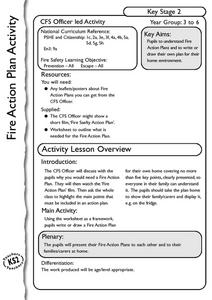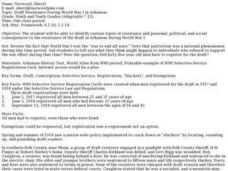Curated OER
Coming to America
Students read one book together about the immigrant experience. Teacher asks students to identify some of the themes around immigration contained in the book (example: prejudice).
Curated OER
Ethical and Personal Decisions
Students will learn about the current technology of genetic testing within the
framework of the biology curriculum through a lesson-produced PowerPoint presentation: "Genetic Testing" at: http://jbois.tripod.com/index.html.
Curated OER
Comprehension: Setting
Learners discuss what setting represents. For this language arts lesson, students review the three elements of setting: where the story takes place, when does the story take place, and is it past, present, or future? Learners create a...
Curated OER
Exploring the 1981 United Nations Declaration on the Elimination of All Forms of Intolerance and of Discrimination Based on Religion or Belief
Students are introduced to the United Nations Declaraion on the Elimination of All Forms of Intolerence and of Discrimination Based on Religion or Belief. Using the document, they discuss issues raised about the source of rights linked...
Curated OER
The United Nations and Women
Students analyze the role of the Commission on the Status of Women in the post-WW II era by looking at the general framework the Committee worked within. They propose their own solutions to the case studies.
Curated OER
Fire Action Plan
Students discuss with a Fire Safety Officer why they need a Fire Action Plan. They then watch the "Fire Action Plan" film highlighting the main points that must be included in the plan and use the worksheet as a framework to draw or...
Curated OER
I Oppose!--Counter-argument/Classifying
Students create an effective classification and counter argument. In this counter-argument lesson, students decide upon a label for at least three types of people and then describe their groups. Students describe three types...
Curated OER
The Outline
In this interesting outlining lesson plan, 5th graders create a house using materials in a shoe box based on an outline they are given. First, students discuss how one can find a main idea, supporting paragraphs,
and facts within...
Curated OER
Love Letters to the World
Students compare three service projects and decide on one to carry out in their community. They determine the opportunity costs of completing one project over another and vote for the one they want to complete. Students realize how...
Curated OER
Historic Takes
Pupils examine photographs of memorials for veterans. They identify who is being honored and why. They research one hero they find interesting and create a memorial for them. They share their hero with the class.
Curated OER
Literature Overview: January
Third graders examine two well known sayings, and write responses to the sayings. They read and analyze various Lewis Carroll poems and his life.
Curated OER
African American Heritage in Arkansas
Students research and write about three African American composers from Arkansas: Scott Joplin, Florence Price and William Grant Still.
Curated OER
Speed + Graphing = Winners!
Fifth graders take addition timed tests every day for a two week period. Using the data from the timed tests, they create a bar graph using Microsoft Excel computer software, a personal bar graph using graph paper and colored pencils,...
Curated OER
Draft Resistance During World War I in Arkansas
Students identify types of resistance and personal, political, and social consequences to the resistance of the draft in Arkansas during World War I. They write a paragraph explaining the draft, and listing two types of draft evasion.
Curated OER
Measuring with My Body
Third graders get into groups of two. Next, give each student a piece of butcher paper that is long enough for them to trace their entire body. One person lies down while their partner traces the outline of their body. Upon completion,...
Curated OER
Thinking inside the Box: Dangers of Tanning Beds
Students research their assigned position pro- or con- for the statement "The use of tanning beds by teens should be regulated" and write a short position paper. They participate in a debate concerning the statement. Students write a one...
Curated OER
Elements of Music
Students identify three of the essential elements of music: rhythm, melody and harmony. They discover a simple song which will illustrate these three elements separately and bring them together in a final form. They analyze and critique...
Curated OER
Fraction Trains
Students examine how multiples of the denominator indicate that a fraction can be renamed as a whole number, and convert improper fractions to mixed numbers. Independently they read examples, and complete a variety of problems on a...
Curated OER
Progress Amidst Prejudice: Portraits of African Americans in Missouri, 1880-1920
Students explore and analyze a database of historical portraits of an African American family of the late 1800's. They trace the migration of one of the African Americans as he/she migrates toward urban areas.
Curated OER
Something Beautiful This Way Comes
Students interview senior citizens in their community about their role in helping others. They compare notes with one of their classmates to see the different ways they have helped the world. They invite their senior citizen to talk to...
Curated OER
Tools For Discussing Haring's Work
Students examine artwork by Keith Haring and discuss his drawing techniques and process. They write a group story as an interpretation of one of Keith Haring's drawings, and create their own posters.
Curated OER
North Korea's Power Play
Students research a number of websites to see how North Korea's leaders have shaped the country. They investigate Korea's ancient history and culture.
Curated OER
Houghton Mifflin Social Studies/Chapter 12, Lesson 1 A Struggle for Rights (pp. 270-274)
Fourth graders examine the time period of the 1960's and 70's to have discussions about three different ethnic groups. They examine the issue of discrimination and civil rights. The lesson includes a helpful outline with a hyperlink.
Curated OER
Disappearing Magic Factors
Young scholars identify, through the number of rows and columns, the factors related to the product. In turn, they also discover how to find the missing factor, which is part of the fact family for that product.























